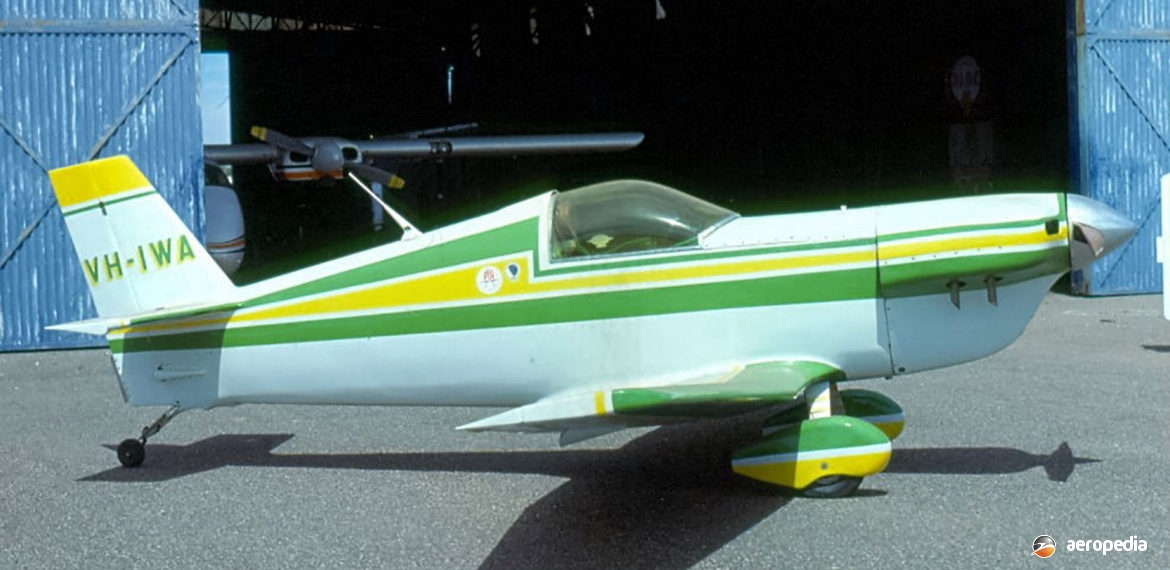Photograph:
Rollason Beta Standard VH-IWA (c/n W.57) at Jandakot, WA (Geoff Goodall)
Country of origin:
United Kingdom
Description:
Single-seat sport monoplane
Power Plant:
One 75 kw (100 hp) Rolls Royce/Continental O-200 four-cylinder horizontally-opposed air-cooled engine
Specifications:
- Wingspan: 6.25 m (20 ft 5 in)
- Length: 5.08 m (16 ft 8 in)
- Height: 1.79 m (5 ft 10 in)
- Wing area: 6.13 m² (66 sq ft)
- Max speed: 322 km/h (200 mph)
- Cruising speed: 267 km/h (166 mph)
- Stalling speed: 97 km/h (60 mph)
- Initial rate of climb: 549 m/min (1,800 ft/min)
- Service ceiling: 6,401 m (21,000 ft)
- Range: 483 km (300 miles)
- Take-off run: 274 m (900 ft)
- Landing run: 427 m (1,400 ft)
- Fuel capacity: 45 litres (10 imp gals)
- Empty weight: 261 kg (575 lb)
- Loaded weight: 393 kg (866 lb)
- Baggage allowance: 9 kg (20 lb)
History:
The design for a single-seat, sporting monoplane of all-wood construction, which became known as the Rollason Beta, resulted from a competition conducted by Rollason Aircraft and Engines in the United Kingdom in 1964. The outline for entries specified a small racing aircraft to be powered by the Rollason Ardem engine of 41 kw (55 hp) with an all-up-weight of 340 kg (750 lb) and a stalling speed not exceeding 97 km/h (60 mph). The competition was won by the Beta, the Taylor Titch was placed second, and the Mitchell-Proctor Kittiwake was third.
The Beta was offered in four versions, B-1 to B-4, each varying mainly in the power plant used. The B-1 was fitted with a 48 kw (65 hp) Continental engine giving a maximum speed of 265 km/h (165 mph) and a cruising speed of 225 km/h (140 mph). The B-2 had a 67 kw (90 hp) Continental C90-8 engine. A 41 kw (55 hp) Ardem 4CO2 Mk V in the B-3 produced a maximum speed of 249 km/h (155 mph) and a cruising speed of 209 km/h (130 mph). A 75 kw (100 hp) Continental O-200 was installed in the B-4, which was a touring rather than a racing variant, with a generator, starter, radio, flaps, and provision for extra fuel. Rollason marketed the B-4 in kit form for amateur builders, supplying materials, prefabricated parts, engines, etc. If required, the Company was also able to supply completed aircraft.
The wing, which had a rectangular centre section and tapered outer panels, was made up of a single main spar consisting of a box with laminated spruce beams and plywood ribs, and an auxiliary rear spar of similar construction with a single web, and plywood covering. The outer sections of the wing were detachable to reduce the width to 2.03 m (6 ft 8 in) so that it could be transported by road. The ailerons were wooden with fabric covering. Flaps were optional. An oval-shaped fuselage was of semi-monocoque structure, with spruce frames and stringers, and plywood covering.
Only one Beta has been completed in this region: VH-IWA (c/n W.57), a Beta Standard, which was completed and flown in Western Australia in 1979. In April 1987 ownership was transferred to an owner in Queensland but the aircraft sustained some damage when it bounced when landing at Kooralbyn, 18 km SW of Beaudesert, QLD on 7 April 1987 and the undercarriage collapsed. It was removed from the farm to storage, repaired and returned to the civil aircraft register on 26 June 1992. In more recent times it has been registered to Linda Walmsley of Coominya, QLD.

